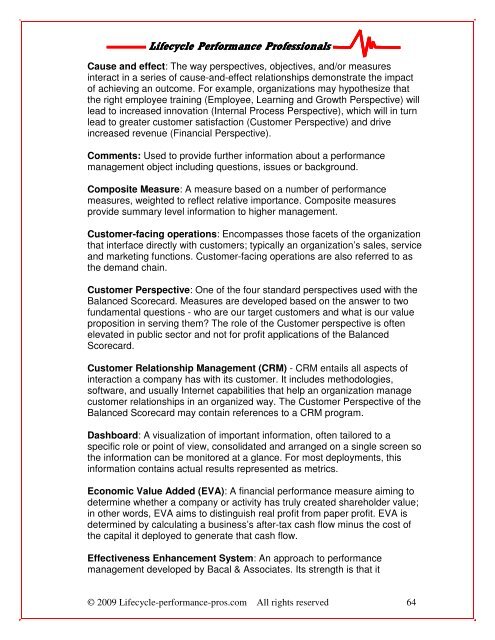Download the Performance Management Fundamentals Guide
Download the Performance Management Fundamentals Guide
Download the Performance Management Fundamentals Guide
Create successful ePaper yourself
Turn your PDF publications into a flip-book with our unique Google optimized e-Paper software.
Lifecycle Lifecycle <strong>Performance</strong> <strong>Performance</strong> Professionals<br />
Professionals<br />
Cause and effect: The way perspectives, objectives, and/or measures<br />
interact in a series of cause-and-effect relationships demonstrate <strong>the</strong> impact<br />
of achieving an outcome. For example, organizations may hypo<strong>the</strong>size that<br />
<strong>the</strong> right employee training (Employee, Learning and Growth Perspective) will<br />
lead to increased innovation (Internal Process Perspective), which will in turn<br />
lead to greater customer satisfaction (Customer Perspective) and drive<br />
increased revenue (Financial Perspective).<br />
Comments: Used to provide fur<strong>the</strong>r information about a performance<br />
management object including questions, issues or background.<br />
Composite Measure: A measure based on a number of performance<br />
measures, weighted to reflect relative importance. Composite measures<br />
provide summary level information to higher management.<br />
Customer-facing operations: Encompasses those facets of <strong>the</strong> organization<br />
that interface directly with customers; typically an organization’s sales, service<br />
and marketing functions. Customer-facing operations are also referred to as<br />
<strong>the</strong> demand chain.<br />
Customer Perspective: One of <strong>the</strong> four standard perspectives used with <strong>the</strong><br />
Balanced Scorecard. Measures are developed based on <strong>the</strong> answer to two<br />
fundamental questions - who are our target customers and what is our value<br />
proposition in serving <strong>the</strong>m? The role of <strong>the</strong> Customer perspective is often<br />
elevated in public sector and not for profit applications of <strong>the</strong> Balanced<br />
Scorecard.<br />
Customer Relationship <strong>Management</strong> (CRM) - CRM entails all aspects of<br />
interaction a company has with its customer. It includes methodologies,<br />
software, and usually Internet capabilities that help an organization manage<br />
customer relationships in an organized way. The Customer Perspective of <strong>the</strong><br />
Balanced Scorecard may contain references to a CRM program.<br />
Dashboard: A visualization of important information, often tailored to a<br />
specific role or point of view, consolidated and arranged on a single screen so<br />
<strong>the</strong> information can be monitored at a glance. For most deployments, this<br />
information contains actual results represented as metrics.<br />
Economic Value Added (EVA): A financial performance measure aiming to<br />
determine whe<strong>the</strong>r a company or activity has truly created shareholder value;<br />
in o<strong>the</strong>r words, EVA aims to distinguish real profit from paper profit. EVA is<br />
determined by calculating a business’s after-tax cash flow minus <strong>the</strong> cost of<br />
<strong>the</strong> capital it deployed to generate that cash flow.<br />
Effectiveness Enhancement System: An approach to performance<br />
management developed by Bacal & Associates. Its strength is that it<br />
© 2009 Lifecycle-performance-pros.com All rights reserved 64










